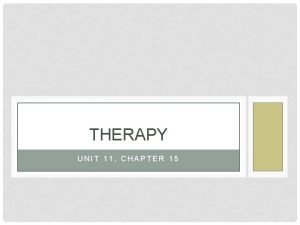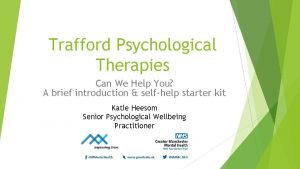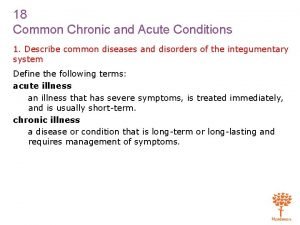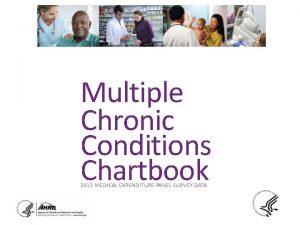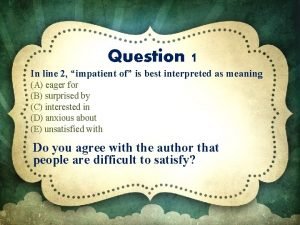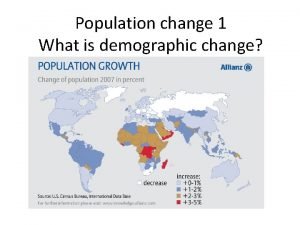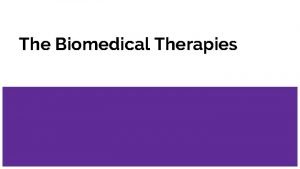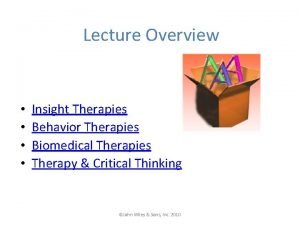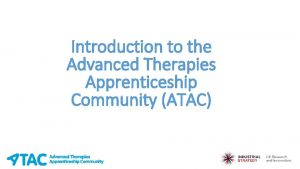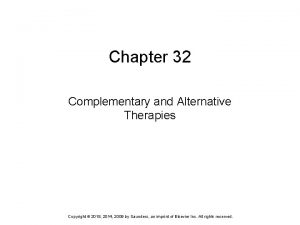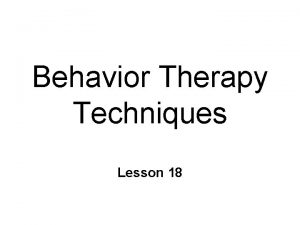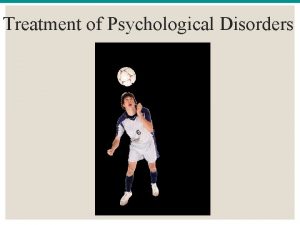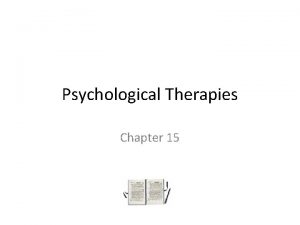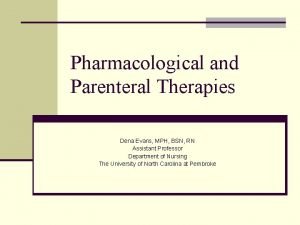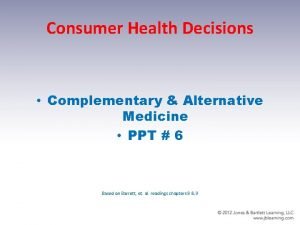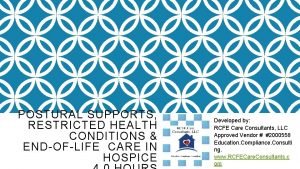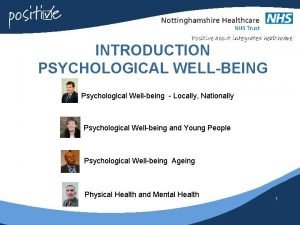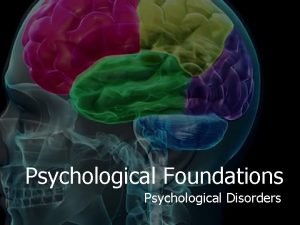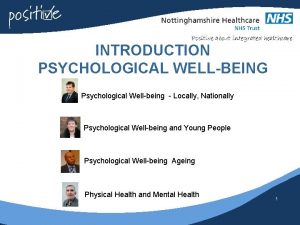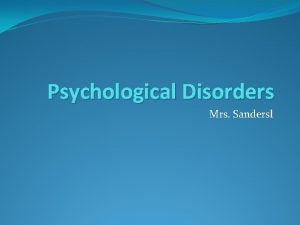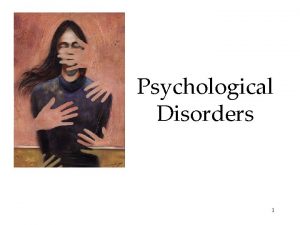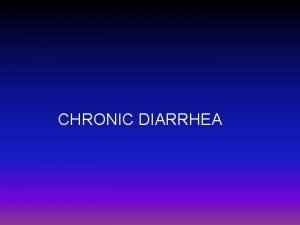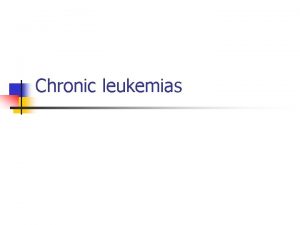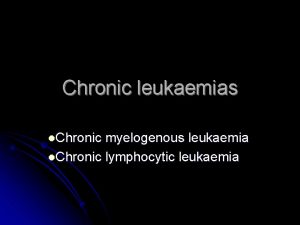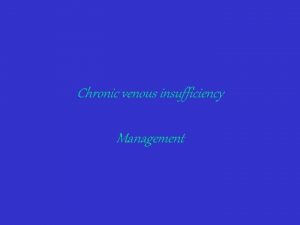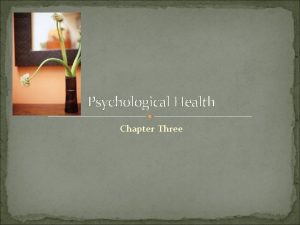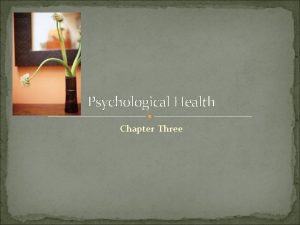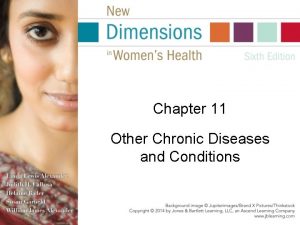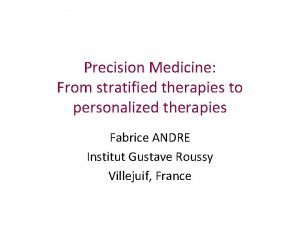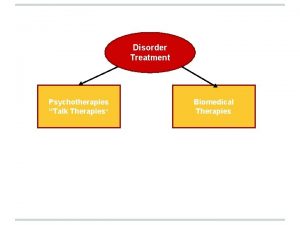Online psychological therapies for chronic health conditions Prospects







































































- Slides: 71

Online psychological therapies for chronic health conditions: Prospects and challenges. Prof. Brian Mc. Guire, School of Psychology & Centre for Pain Research, National University of Ireland, Galway brian. mcguire@nuigalway. ie School of Psychology

Overview • Chronic conditions and move towards self-management. • Describe benefits and growing use of internet-based psychological therapies for coping and adapting to chronic health conditions. • Research findings on chronic pain, chronic fatigue following cancer, and ongoing projects. • Some of the challenges in making therapies more widely available. School Institute Name to go here

Chronic health conditions and self-management • Chronic (>1 year) illnesses, impairments or conditions that limit functioning and may require ongoing medical care. School Institute Name to go here

Self-management means the tasks that individuals must undertake to live with one or more chronic (long-term) health conditions such as diabetes, heart failure, asthma or chronic obstructive pulmonary disease (COPD). Self-management support is the provision of education and supportive interventions, to increase patients’ skills and confidence in managing their health problems. It includes regular assessment of progress and problems, goal setting, and problem-solving support. Living Well with a Chronic Condition: Framework for Self-management Support National Framework and Implementation Plan for Self-management Support for Chronic Conditions: COPD, Asthma, Diabetes and Cardiovascular disease. Health Service Executive, Nov. 2017. School Institute Name to go here

What is Pain? “An unpleasant sensory and emotional experience associated with actual or potential tissue damage…. ” (IASP, 1994). Acute - less than 3 months Chronic - longer than 3 months, most days

Aims of the PRIME study • • Longitudinal, epidemiological study Chronic non-cancer pain. Prevalence of chronic pain. Incidence of pain in a 12 -month period. Persistence of pain problems over 12 -months. Impact - physical, psychological, social. Cost - health service utilisation, social welfare support, and lost productivity (Raftery et al, Pain 2011, J Pain 2012)

Prevalence and Duration of Pain • • • 35% had CP based on IASP definition. Average duration 7. 6 years (range 3 months - 50 years). 23. 6% pain for < 12 months. 26. 4% pain from 1 -5 years. 15. 7% pain from 5 -10 years. 21. 5% pain more than 10 years.

Where is the pain? • Lower back primary site of pain and most limiting for all age groups except those >75 years - knee pain most limiting • 80% had pain in more than one site, 45% had 4 or more sites of pain School of |Psychology & Centre for Pain Research

Work ability is affected by pain • Vast majority of the chronic pain sample was working fulltime – but 12% unable to work or working part time due to pain. • Those with chronic pain were over 3 times more likely to be unemployed. • Semi skilled workers were more than 3 times more likely than professionals to report chronic pain.

Depression and Pain. Proportion of people with clinically significant HADS Depression score (>10) Pain Group No-Pain group Male 13% 3% Female 15% 3. 7% Clinically significant depression nearly 5 times more common in chronic pain. Centre for Pain Research

Cost of Pain • Average cost per chronic pain patient € 5, 665 per year • Costs increased according to severity of pain. • Total cost estimated at € 4. 76 billion per year, 2. 55% of Irish GDP in 2008. • Intensive users – average 4 inpatient admissions per year, 8 outpatient visits per year, 9 GP visits per year. • Small proportion of patients account for most of costs - 5% most expensive patients accounted for 26. 4% of costs - average cost per patient € 29, 936 – hospital and wage replacement. Centre for Pain Research

Pain in vulnerable populations School of |Psychology & Centre for Pain Research

Q: Is pain only an adult health problem? Prevalence, Impact and Cost of Chronic Non. Cancer Pain in School-Aged Children: PRIME-C. Centre for Pain Research

Prevalence of Chronic Pain in 9 -12 yr Olds 9% of 9 -12 year olds Severity of Pain report having chronic Category Percentage pain A little Pain 20 % Some Pain 38 % A lot of Pain 18 % Note: 24% did not indicate severity level of pain

Prevalence of Chronic Pain in 5 -8 yr Olds (n=395) 7% of 5 -8 yr Severity of Pain olds report having chronic Category Percentage pain A little Pain 29 % Some Pain 29 % A lot of Pain 14 % Note: 28% did not report severity level of pain

KID Kindl Quality of Life Measures Comparing Children With and Without Pain 9 -12 yr old children with pain obtain significantly lower scores on all the KID Kindl QOL Measures Measure Do children with pain do worse? Physical Score Yes Emotional Score Yes Self-Esteem Score Yes Family Score Yes Friends Score Yes School Score Yes Total Score Yes

KID Kindl Quality of Life Measures Comparing Children With and Without Pain 9 -12 yr old children with pain obtain significantly lower scores on all the KID Kindl QOL Measures Measure Do children with pain do worse? Physical Score Yes Emotional Score Yes Self-Esteem Score Yes Family Score Yes Friends Score Yes School Score Yes Total Score Yes

The PAIN–ID Study The Prevalence and Impact of Chronic Pain in Adults with an Intellectual Disability Based on Carer Report (Walsh, Morrison, Mc. Guire. Pain 2011, 152: 1951 -1957). Centre for Pain Research

Do people with ID have problems with pain? • IASP notes that pain also occurs in people unable to communicate verbally. Pain expressed differently in verbal vs non-verbal people. • Greater risk of experiencing pain: - Co-morbid conditions especially musculoskeletal - Increased accidental injury - Unhealthy lifestyle - Difficulty communicating pain and accessing treatment (Defrin et al. , 2004; Mc. Guire et al, 2007; Robertson et al, 2000; van Schrojenstein, 2000). • Pilot study – 13% - mild 2. 5 more likely to have CP: possible under-recognition and under-treatment of pain in this group (Mc. Guire et al, J Intell Disabil Res 2010) School Institute Name to go here

The extent of chronic pain • 15. 4% (n=116) of the sample were reported to experience chronic pain with varying levels of severity • Pain was experienced for an average of 75 months / 6. 3 years (SD = 92. 8; Range = 3 -468 months)

Do people with Down Syndrome experience pain differently? • People with DS have a • BUT a higher sensitivity higher pain threshold – i. e. once pain is registered, i. e. takes longer to register pain. people with DS have a more rapid summation of pain – once pain is registered will get more sore, more quickly. Mc. Guire & Defrin 2015, Front Behav Neurosc. School Institute Name to go here

The features of pain in older adults • Affects >50% community and >70% residential • Pain is often multi-focal and multi-factorial • Common types: – Musculoskeletal – Internal organ – Neuropathic

Obstacles to getting effective pain management – (1) Not reported • Older adults may be less likely to report pain, because of : – cognitive impairment – stoicism or a desire not to be a burden on caregivers – belief that pain is a normal consequence of aging School of |Psychology & Centre for Pain Research

Obstacles to getting effective pain management – (2) Not asked about • Older adults may not be asked about their pain because: – Comorbidities are common, other health concerns may take priority – Health professionals less likely to ask older patients about pain – Pain may not look like pain (atypical especially in cog. impaired) – Pain assessment may be too difficult • Sensory loss • Cognitive impairment and other medical illnesses School of |Psychology & Centre for Pain Research

Obstacles to getting effective pain management – (3) Not treated • Health professionals less likely to offer treatments for pain or may manage pain differently in older patients. – Less likely to be given the same amount of analgesia as younger people in surgical settings – People >70 were less likely than younger patients to be recommended physiotherapy, exercise, or to be referred to a pain specialist or for CBT. School of |Psychology & Centre for Pain Research

Consequences of Untreated Pain in Elderly • It is estimated that 80% of nursing home residents have substantial pain that is undertreated • Untreated pain results in: – depression – decreased socialization – sleep disturbance – impaired ambulation – behavioral problems » AGS Panel on Chronic Pain in Older Persons, 1998

School of |Psychology & Centre for Pain Research

What can we do? • Pain is highly prevalent • Pain impacts quality of life • Pain is expensive • -> Need for interventions to reduce cost and reduce suffering Centre for Pain Research

Could we use online psychological therapies to manage chronic pain? Centre for Pain Research

Why Online Psychological Therapies? • • • Scarce resource Waiting lists Physical symptoms that limit mobility Distance from a clinic / transportation requirements Cost constraints Choice Centre for Pain Research

What are e-Pain Technologies? e-Pain technologies can be divided into 3 main types: (1) Pain symptom diaries (2) Sensors and wearable devices for collecting real time data such as exercise data, sleep activity, and other physiological data (3) Online and app-based interventions for managing pain (primarily psychological and activity-focused treatments) School of Psychology

Symptom recording: Pain App for Children Centre for Pain Research

Sensors and biofeedback devices School Institute Name to go here

Are e-Interventions Effective for Pain Coping? • Web-based interventions show a clear trend of effectiveness, with stronger evidence emerging in more recent studies. Ø Two Cochrane reviews found evidence that Internetbased treatments reduced pain, disability, depression, and anxiety in adults and children. • There is an absence of evidence to yet recommend mobile app interventions (as opposed to evidence of a lack of effect). School of Psychology

Ongoing Challenges in the Development and Evaluation of E-pain Interventions 1) Limited capability for personalization of treatment. 2) Lack of involvement of health professionals in development and evaluation of technologies. 3) Insufficient foundation in current research or behavioural theories. 4) Lack of scientific evaluation through feasibility or effectiveness testing. – Are the interventions fit for purpose-safe and clinically effective? – What are the effective components? – What is the best format for delivery of the intervention (is therapist contact needed, how much, how often)? – Who benefits from the interventions? – Are they cost-effective? School of Psychology

Features of typical e-pain intervention model School of Psychology

Mindfulness and chronic pain Developing and pilot-testing Mindfulness in Action online intervention H Dowd, M Hogan, B Mc. Guire, K Sarma, R Fish, A Zautra (Clinical Journal of Pain, 2015) 37

Mindfulness online. • 126 participants with self-reported chronic pain were randomly assigned to each condition. • Participants in both programmes reported significant improvement across a range of measures, including pain acceptance, pain catastrophising, pain interference, and ratings of pain at its worst and pain now, and global impressions of change. • Also found unique benefits for the MIA programme, specifically, for ratings of pain intensity, ability to manage emotions, ability to deal with stressful situations, and ability to enjoy pleasant events. School of |Psychology & Centre for Pain Research

ADAPTATION OF WEB-MAP School Institute Name to go here

Web-based Management of Adolescent Pain (Web-MAP) • Web-MAP is an interactive and personalized CBT intervention for paediatric chronic pain that has shown promise in studies in US and Canada. • Currently, there is no online intervention that focuses on pain management for adolescents and their parents in Ireland. • In the context of the limited number of pain management services available for children and young people in Ireland, our objective is to evaluate the feasibility and outcomes of the Web-MAP programme within an Irish population and provide important information about the usability, acceptability, and preliminary data on efficacy of an online paediatric pain management intervention. School Institute Name to go here

Methodology Participants: 20 adolescents and their parent(s). Inclusion criteria: 1016 years, pain present for >3 months. Mixed design: • - Quantitative measures of pain will be taken at baseline and posttreatment. • - Qualitative data will be gathered at the end from post-treatment interviews to explore likes and dislikes about the programme Intervention: The Web-MAP programme has 8 modules in total to be completed by both child and parent each week. School Institute Name to go here

Results • Significant reductions in child pain intensity, pain interference, pain catastrophizing, activity limitations pre to post-treatment. • Parents showed significant reduction in protective behaviours pre to post-treatment. • Qualitative data revealed very positive feedback in relation to the usability and effectiveness of the programme, with both children and parents reporting high satisfaction ratings for the content and acceptability of the programme. • Next step: Full evaluation of effectiveness School Institute Name to go here

ADAPTATION OF THE PAIN COURSE School Institute Name to go here

OBJECTIVES • Pilot study to generate an understanding of participants’ perceptions of the usability and acceptability of the Pain Course in a sample of adults with chronic pain, living in Ireland. • To investigate the effectiveness of the intervention in a clinical trial. School of Psychology

Methods • Design : Two group, randomised controlled study. • Participants : Adults with self-reported chronic pain, registered at local hospital pain clinic. Assessments conducted via a screening telephone interview and online questionnaire. 133 people randomised to treatment or control. • Measures : – Acceptability and satisfaction assessed at post-treatment. – Clinical outcome data collected via administration of measures of mood (PHQ -9), andxiety (GAD-7), disability (RMDQ), pain intensity (WBPQ), pain interferrence (PIQ), pain self-efficacy (PSEQ-2), fear of movement because of pain (TSK), pain acceptance (CPAQ 8); at pre-treatment, post-treatment, 3 month f-up. All administered online. School of Psychology

Methods Intervention: The Pain Course is an established online CBT pain management programme comprising : • Five core online lessons • Homework assignments • Additional resources and detailed case studies • Course components released sequentially over an 8 -week period with weekly email and phone contact with a clinician • Contact to support participants work through Course and apply skills School of Psychology

Results • Mean Age 45 years (SD 11. 34) Ø 106 female (49. 6%) Ø 27 males (20. 3%) • All lessons completed by 80% TG • 85% TG completed post treatment data • 99% CG completed post treatment data • Clinician contact per participant was 81. 06 minutes ü Significant differences on all outcome measures.

Measures Means, SDs, and effect sizes Medium >. 5 Large >. 8) Pretreatment Posttreatment Disability Treatment Control Depression Treatment Control Anxiety Treatment Control Self-Efficacy Treatment Control Fear of movement Treatment Control Pain acceptance Treatment Control Pain intensity Treatment Control Pain interference 14. 50 (4. 24) 14. 46 (4. 77) 11. 83 (5. 51) 12. 10 (5. 68) 8. 89 (4. 74) 9. 81 (5. 43) 23. 59 (11. 80) 25. 18 (11. 58 11. 96 (4. 78) 14. 17 (5. 03) 6. 62 (4. 08) 11. 60 (5. 57) 5. 56 (3. 98) 9. 19 (5. 63) 34. 46 (11. 50) 27. 18 (11. 43) 38. 89 (8. 26) 39. 75 (8. 03) 22. 38 (8. 23) 21. 37 (7. 76) 5. 65 (1. 51) 5. 91 (1. 19) 33. 62 (7. 29) 38. 55 (7. 33) 27. 19 (6. 53) 22. 37 (7. 83) 5. 14 (1. 77) 5. 96 (1. 52) Treatment Control 6. 74 (1. 97) 6. 60 (1. 96) 5. 44 (2. 12) 6. 48 (1. 97) Posttreatment effect sizes between-group (CI) . 45 (. 11 to. 79) 1. 01 (. 65 to 1. 38) . 74 (. 39 to 1. 09) . 64 (. 29 to. 98) . 67 (. 32 to 1. 02) . 50 (. 15 to. 84) . 51 (. 16 to. 85)

Feasibility and Pilot Testing of an Online Intervention for Post-Treatment Cancer Survivors Teresa Corbett, Ann. Marie Groarke, Jane Walsh, Brian Mc. Guire, Niamh Gethin.

Aim of Study n Design an on-line CBT intervention to enable self management of fatigue in post-treatment survivors n Pilot RCT to test feasibility and potential effectiveness of this intervention

Cancer Related Fatigue (Cr. F) n Most common and disruptive symptom in survivors n Not proportional to recent activity n Can persist in about one-third of those with cancer (Bower 2012) n Fatigue that persists >3 mths post treatment unlikely to decrease of its own accord (Goedendrop et al. 2013)



Interaction Effects 2 x 2 ANOVA Group x Time p . 01 Qol in Adult Cancer Survivors Financial concerns F = 7. 25 Qol in Adult Cancer Survivors Distress /Recurrence F = 6. 66 p . 01 Cognitive and Behavioural responses to Symptoms All or nothing behaviour F = 4. 36 p . 05 Cognitive and Behavioural responses to Symptoms Avoidance /resting behaviour F = 4. 42 p . 05

Satisfaction n Mostly satisfied with REFRESH program and likely to use again if their fatigue persists n Agreed Internet good method for delivering the REFRESH intervention n The open-ended questions highlighted that participation in the research served as validation of their Cr. F experiences “It is reassuring to me (and I’m sure to others) that you’re even doing the research so Cr. F must be a problem”

Literature Analysis Qualitative Assessment Prototype Development and Testing Feasibility Trial Development of Feeling Better: A web-based pain management programme for children with chronic pain and their parents. Angeline Traynor, Jonathan Egan and Brian Mc. Guire

The Challenge……. . • To convert a paper treatment manual to an online format – Feeling Better manual (Mc. Manus & Mc. Guire 2010). – Aims: (i) increase perceived competence (ii) expand range of coping skills (iii) enhance function despite pain • To modify the content from a treatment program designed for carers of people with an intellectual disability to suit carers of young, typically developing children. • To evaluate the acceptability and effectiveness of the program

Methods Identify the evidence base: – Systematic review of empirical literature Identify or develop relevant theoretical framework: – Qualitative - barriers and facilitators to paediatric chronic pain selfmanagement - children and their care-givers. Modelling Process and Outcomes – Qualitative mixed methods (a) evidence from the literature and (b) input from potential end-users incorporated to promote pain self-management. Feasibility and Piloting Phase – Feasibility of undertaking a randomised controlled trial. Estimates of effect on clinical outcomes.

Qualitative study 1 Aim: To explore the support needs and coping preferences of potential users Methods: • Participative research process (PRP) approach • Children with chronic pain (5 -12 years), n=16; Parents n=21. – – Phase 1: Generate data Phase 2: Categorise responses Phase 3: Organise categories / analyse patterns Phase 4: Integration of schema


Mixed methods, usertesting Aims: • To elicit participants’ perceptions of technology as a mode of treatment delivery (prototype) Methods: • Children (n=19), ages 5 -12 years; Parents (n=19) – Think-aloud Group: Children (n=6) Parents (n=6) – PRP Group: Children (n=5) Parents (n=5) – Online User-testing: Children (n=8) Parents (n=8)

Modifcations Qualitative and user-testing data informed: storyboards - specifically developed features selection of strategies - areas identified as challenging targets for treatment identified as most important the prominence and sequence of certain strategies tailoring and personalisation throughout the programme

Modifications Type of comment Feedback Modification Content “make it about us, not just pain” Weekly progress report for children and parents Layout/navigatio “make it compulsory or she Tunnelled navigation, n wont do what she needs to do”; homework submission not “allow some options” compulsory User experience “show progress - that'll keep her on it“; “Personalise it”; “automatic encouragement”; “Provide printable versions” More automated features (messages, reminders); progress bar; Pirate Pouch pdf’s; Instant messaging and Pirate Post (internal message centre) Graphics/theme “Pirate characters we can follow” Move up the ranks (incentive) Comprehension “clarify goal-setting”; “Use Option to create own goals plus more diagrams to help explain”; pre-defined list

Self-monitoring BCT 1. 4 action planning; BCT 2. 3 Selfmonitoring of behaviour Interactive action plan, online pain diary, weekly check-in & check out Goal-setting BCT 1. 1 Goal setting (behaviour) Weekly, interactive SMART goal setting Self-reward (reinforcement) BCT 10. 3 Nonspecific reward; BCT 10. 9 selfreward Weekly, interactive selfreward setting Problem solving BCT 1. 2 Problem -solving; BCT 1. 4 Action planning Mission 7 Interactive problem-solving strategies, BCT 11. 2 reduce negative emotions Mission 3, 5, 6 Gudided visualisation, Interactive cognitive restructuring, emotion coping strategies, Self-regulation Affective selfreaction


Feasibility trial • Ongoing, two-arm randomised controlled feasibility trial (experimental group and waiting list control) • Evaluate the feasibility, acceptability and potential efficacy • Assessment at baseline, post-intervention (9 -11 weeks) and at 3 month follow-up • 9 Missions (modules), 1 per week, 30 mins to complete • Complementary section for parents

Ongoing studies • An app to predict future risk of pain-related disability • Participate programme for social anxiety • Acceptance and Commitment Therapy (ACT) for multimorbidity • ACT for feelings of anger and injustice in chronic pain • Mindfulness-based CBT for well-being in MS • Augmented Reality Therapy for phantom limb pain School Institute Name to go here

Should E-pain Interventions be Regulated? • Less safety and recourse for patients who avail of e-pain interventions via an mobile app or web than those who attend clinicians. • The delivery of e-pain services should be subject to the same ethical guidelines as apply to face-to-face treatments. • It is an imperative to ensure that e-pain technologies are appropriately evaluated and disseminated. School of Psychology

Improving Access to E-pain Technologies • (1) A curated list of interventions that are (a) usable and (b) have evidence for effectiveness • (2) Endorsement by an appropriate organization (eg, a professional body) • (3) Practice infrastructure for e-technology prescribing and monitoring progress • (4) Training for health care providers to prescribe and supervise e-pain interventions • (5) Mechanism to monetise prescribing and monitoring • (6) Meets privacy and security regulations School Institute Name to go here

• (7) Protection of the prescriber and the institution from liability arising from technology usage • (8) Low or no cost for the user • (9) Has an impact on patient outcomes • (10) Compatible with existing health record systems • (11) A system to monetise the intervention owner so that the service can be maintained, improved, and expanded. School Institute Name to go here

Conclusions • Findings offer preliminary support for the immediate effects of an 8 -week online ACT intervention for chronic pain • Next steps: – Examine 3 -month follow-up data • Final questionnaires due in October – Analyse cost-effectiveness data • Future directions: Thank you! – Comparison of ACT online versus face-to-face?
 Psychodynamic vs psychoanalytic
Psychodynamic vs psychoanalytic Trafford psychological therapies
Trafford psychological therapies Trafford psychological services
Trafford psychological services Trafford psychological therapies
Trafford psychological therapies Trafford psychological therapies
Trafford psychological therapies Common chronic and acute conditions chapter 18
Common chronic and acute conditions chapter 18 Multiple chronic conditions chartbook
Multiple chronic conditions chartbook The principal contrast in the passage is between
The principal contrast in the passage is between Quantum computing: progress and prospects
Quantum computing: progress and prospects Prospects of agriculture in bangladesh
Prospects of agriculture in bangladesh World population prospects
World population prospects Prospects preposition
Prospects preposition Flinders model of chronic care self-management limitations
Flinders model of chronic care self-management limitations Four components of psychological health
Four components of psychological health Module 73 the biomedical therapies
Module 73 the biomedical therapies Biomedical therapy
Biomedical therapy Stiriti ayur therapies private limited
Stiriti ayur therapies private limited Talking therapies westminster
Talking therapies westminster Insight therapy definition
Insight therapy definition Advanced therapies apprenticeship community
Advanced therapies apprenticeship community Chapter 32 complementary and alternative therapies
Chapter 32 complementary and alternative therapies Acceleration behavioral therapies
Acceleration behavioral therapies Psychoanalytic therapy is to as humanistic therapy is to
Psychoanalytic therapy is to as humanistic therapy is to Psychoanalytic therapy is to as humanistic therapy is to
Psychoanalytic therapy is to as humanistic therapy is to Biomedical therapy definition
Biomedical therapy definition Blincyto fda
Blincyto fda Pvu
Pvu Bodywork and movement therapies
Bodywork and movement therapies Insight therapies involve verbal interactions
Insight therapies involve verbal interactions Advantages of group therapy
Advantages of group therapy Pharmacological and parenteral therapies
Pharmacological and parenteral therapies Complementary and alternative medicine ppt
Complementary and alternative medicine ppt Title 22 restricted health conditions
Title 22 restricted health conditions Fspos vägledning för kontinuitetshantering
Fspos vägledning för kontinuitetshantering Novell typiska drag
Novell typiska drag Nationell inriktning för artificiell intelligens
Nationell inriktning för artificiell intelligens Vad står k.r.å.k.a.n för
Vad står k.r.å.k.a.n för Varför kallas perioden 1918-1939 för mellankrigstiden
Varför kallas perioden 1918-1939 för mellankrigstiden En lathund för arbete med kontinuitetshantering
En lathund för arbete med kontinuitetshantering Särskild löneskatt för pensionskostnader
Särskild löneskatt för pensionskostnader Tidbok för yrkesförare
Tidbok för yrkesförare Anatomi organ reproduksi
Anatomi organ reproduksi Förklara densitet för barn
Förklara densitet för barn Datorkunskap för nybörjare
Datorkunskap för nybörjare Tack för att ni lyssnade bild
Tack för att ni lyssnade bild Debattartikel struktur
Debattartikel struktur Delegerande ledarstil
Delegerande ledarstil Nyckelkompetenser för livslångt lärande
Nyckelkompetenser för livslångt lärande Påbyggnader för flakfordon
Påbyggnader för flakfordon Tryck formel
Tryck formel Publik sektor
Publik sektor Kyssande vind analys
Kyssande vind analys Presentera för publik crossboss
Presentera för publik crossboss Vad är ett minoritetsspråk
Vad är ett minoritetsspråk Vem räknas som jude
Vem räknas som jude Klassificeringsstruktur för kommunala verksamheter
Klassificeringsstruktur för kommunala verksamheter Luftstrupen för medicinare
Luftstrupen för medicinare Bästa kameran för astrofoto
Bästa kameran för astrofoto Cks
Cks Byggprocessen steg för steg
Byggprocessen steg för steg Bra mat för unga idrottare
Bra mat för unga idrottare Verktyg för automatisering av utbetalningar
Verktyg för automatisering av utbetalningar Rutin för avvikelsehantering
Rutin för avvikelsehantering Smärtskolan kunskap för livet
Smärtskolan kunskap för livet Ministerstyre för och nackdelar
Ministerstyre för och nackdelar Tack för att ni har lyssnat
Tack för att ni har lyssnat Vad är referatmarkeringar
Vad är referatmarkeringar Redogör för vad psykologi är
Redogör för vad psykologi är Borstål, egenskaper
Borstål, egenskaper Tack för att ni har lyssnat
Tack för att ni har lyssnat Borra hål för knoppar
Borra hål för knoppar Vilken grundregel finns det för tronföljden i sverige?
Vilken grundregel finns det för tronföljden i sverige?
